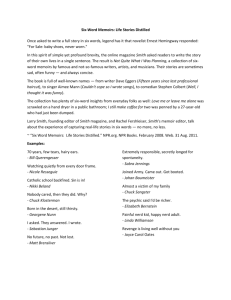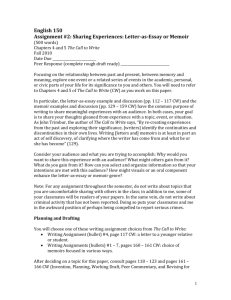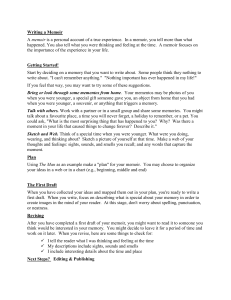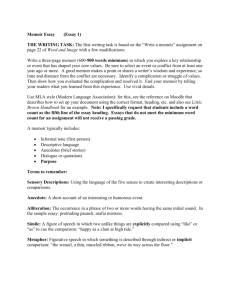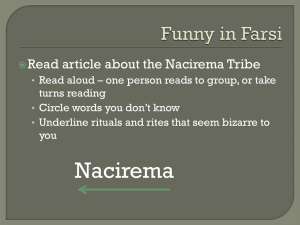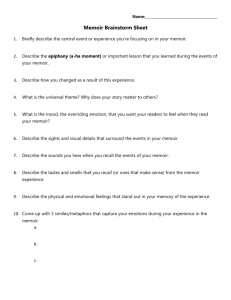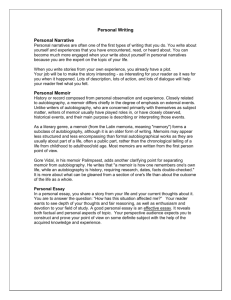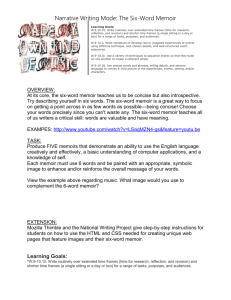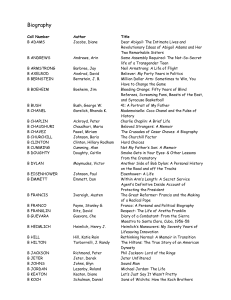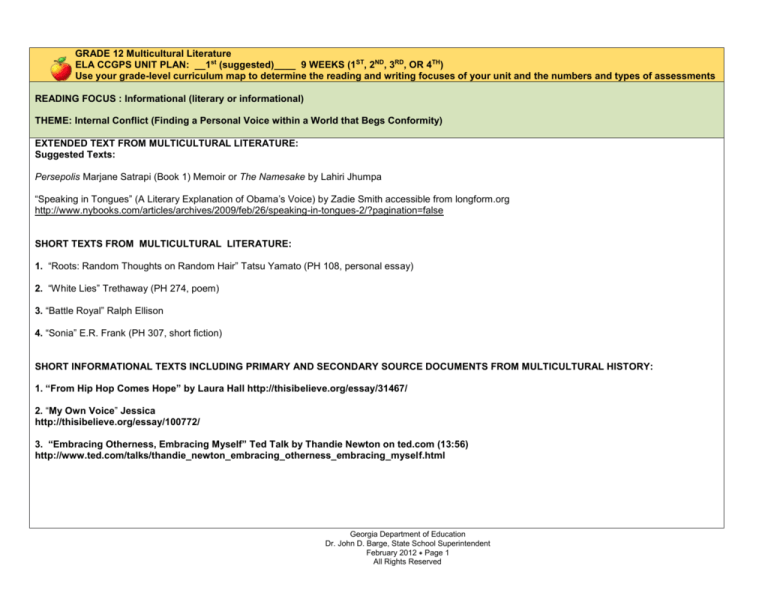
GRADE 12 Multicultural Literature
ELA CCGPS UNIT PLAN: __1st (suggested)____ 9 WEEKS (1ST, 2ND, 3RD, OR 4TH)
Use your grade-level curriculum map to determine the reading and writing focuses of your unit and the numbers and types of assessments
READING FOCUS : Informational (literary or informational)
THEME: Internal Conflict (Finding a Personal Voice within a World that Begs Conformity)
EXTENDED TEXT FROM MULTICULTURAL LITERATURE:
Suggested Texts:
Persepolis Marjane Satrapi (Book 1) Memoir or The Namesake by Lahiri Jhumpa
“Speaking in Tongues” (A Literary Explanation of Obama’s Voice) by Zadie Smith accessible from longform.org
http://www.nybooks.com/articles/archives/2009/feb/26/speaking-in-tongues-2/?pagination=false
SHORT TEXTS FROM MULTICULTURAL LITERATURE:
1. “Roots: Random Thoughts on Random Hair” Tatsu Yamato (PH 108, personal essay)
2. “White Lies” Trethaway (PH 274, poem)
3. “Battle Royal” Ralph Ellison
4. “Sonia” E.R. Frank (PH 307, short fiction)
SHORT INFORMATIONAL TEXTS INCLUDING PRIMARY AND SECONDARY SOURCE DOCUMENTS FROM MULTICULTURAL HISTORY:
1. “From Hip Hop Comes Hope” by Laura Hall http://thisibelieve.org/essay/31467/
2. “My Own Voice” Jessica
http://thisibelieve.org/essay/100772/
3. “Embracing Otherness, Embracing Myself” Ted Talk by Thandie Newton on ted.com (13:56)
http://www.ted.com/talks/thandie_newton_embracing_otherness_embracing_myself.html
Georgia Department of Education
Dr. John D. Barge, State School Superintendent
February 2012 Page 1
All Rights Reserved
Supplemental Materials: many supplemental materials are linked to the assessments and tasks within the unit.
The Six Word Memoir
http://www.smithmag.net/sixwords/ (examples of six word memoirs)
http://www.npr.org/programs/totn/features/2008/02/memoir/gallery/index.html (gallery of six word memoirs with images)
Bio or Story Cube Resources (for assistance in understanding a text)
http://www.readwritethink.org/files/resources/interactives/cube_creator/
Other Retellings of the My Fair Lady Story (from http://www.mccarter.org/Education/myfairlady/index.html#change)
Beginning with Ovid, the Pygmalion story has been interpreted and adapted by countless writers and artists. There have been several examples of creators
whose experiments have unforeseen implications. Faust, Dr. Frankenstein and Svengali are cases in point.
1983
Trading Places starring Eddie Murphy Educating Rita starring Michael Caine
1987
Can't Buy Me Love starring Patrick Dempsey Overboard starring Goldie Hawn
Mannequin starring Kim Cattrall
1990
Pretty Woman starring Julia Roberts
1999
She's All That starring Freddie Prinze Jr.
2001
The Princess Diaries starring Julie Andrews
2006
The Namesake (multicultural)
1995
Clueless
This theme lives on and can be found in recent films as well. In the following films, the teacher or mentor is older, condescending, and intellectual, while the
student is dehumanized even as (s)he makes the way up the social ladder. At last, the teacher is forced (perhaps too late) into recognizing his 'creation' as an
equal.
“Black? White? Asian? More Young Americans Choose All of the Above” (New York Times Article) with an accompanying 5 minute video clip
http://www.nytimes.com/2011/01/30/us/30mixed.html?scp=1&sq=black?%20white?%20asian?%20more%20young%20americans%20choose%20all%20of%2
0the%20above&st=cse (This article would be interesting to look at in light of Thandie Newton’s Ted Talk and would relate to many students who are
multiracial). This article would also promote interesting discussions in schools where diversity is limited.
Resources for teaching The Namesake:
These links include an author video interview, discussion questions, and a complete unit plan. The Namesake is recommended by corestandards.org
appendix B as a recommended text.
Georgia Department of Education
Dr. John D. Barge, State School Superintendent
February 2012 Page 2
All Rights Reserved
http://www.hmhbooks.com/readers_guides/lahiri_namesake.shtml (author interview and discussion questions)
http://aschoenbart.com/portfolio/artifacts/planning/namesake.pdf (a complete novel lesson plan)
http://www.hostos.cuny.edu/oaa/book/book2/guidejl.htm (study guide)
WRITING FOCUS: Argumentative and Informative/Explanatory
ASSESSMENT TASKS (These writing prompts will serve as the assessments for this unit.)
Informative/Explanatory writing should focus on why literary and rhetorical choices are made by the author, and how those choices are intended to affect or
impact the reader based solidly in text evidence; argumentative/opinion writing must advance a specific claim or claim(s) and provide strong and logical
support, based solidly in text, for claims.
1. Writing two six word memoirs for different purposes and examine how they overlap
2. Find a current article that connects to one of the pieces or the unit essential question we have read in class and write a rhetorical précis for the
article that you will present to the class.
3. Persepolis short answer assessment
4. Write a “This I Believe” essay that explains how you maintain your personal integrity (voice, beliefs) within a world that begs conformity.
(UP TO TWO ADDITIONAL ANALYSIS PROMPTS PER UNIT AT INSTRUCTOR DISCRETION)
5. Lesson plans for The Namesake under supplemental materials
6.
NOTE: AT LEAST 3 OF THE MINIMUM OF 4 ANALYSIS ESSAYS MUST BE WITH THE GENRE FOCUS IDENTIFIED FOR THE UNIT
NARRATIVE/RESEARCH/ROUTINE WRITING
NARRATIVE
1. Six word memoir(s)
2. Quick writes/Journals
Georgia Department of Education
Dr. John D. Barge, State School Superintendent
February 2012 Page 3
All Rights Reserved
RESEARCH CONNECTION(S)
Articles Supporting Assessment 2
Research Comparing and Contrasting Two Narratives (part of assessment 3)
Research on Iran (Part of assessment 3)
ROUTINE WRITING Notes, summaries, process journals, and short responses across all genres
Brainstorming the Six Word Memoir (s)
Quick Writes on Theme in Each Thematically Linked Literary Text
Reflections
Notes on Research
Graphic Organizer (Compare and Contrast)
PLANS FOR ASSESSMENT 1: integrating reading selections from the unit into a writing task
Students will create two six word memoirs for different purposes and examine how they overlap.
SKILL BUILDING TASKS Note: tasks may take more than a single day.
Include a task to teach EVERY skill students will need to succeed on the assessment prompt above. Language, Foundations, and Speaking/Listening
standards must be incorporated so that all standards are adequately addressed throughout the year.
ESSENTIAL QUESTION: What defines you as an individual?
TASK: Creating a six word memoir that defines who you are
Lesson from
http://www.readwritethink.org/classroom-resources/lesson-plans/exploring-power-language-with-30701.html?tab=4#tabs
Standards:
ELACC11-12W3: Write narratives to develop real or imagined experiences or events using effective technique, well-chosen details, and well-structured
event sequences.
d. Use precise words and phrases, telling details, and sensory language to convey a vivid picture of the events, experiences, setting and/or characters.
ELACC11-12W4: Produce clear and coherent writing in which the development, organization, and style are appropriate to the task, purpose, and
audience.
ELACC11-12W5: Develop and strengthen writing as needed by planning, revising, editing, rewriting, or trying a new approach, focusing on addressing on
what is most significant or a specific purpose or audience.
LACC11-12W10: Write routinely over extended time frames and shorter time frames for a range of tasks, purposes, and audiences.
ELACC11-12L3: Apply knowledge of language to understand how language functions in different contexts, to make effective choices for meaning or style,
and to comprehend more fully when reading or listening.
Georgia Department of Education
Dr. John D. Barge, State School Superintendent
February 2012 Page 4
All Rights Reserved
ELACC11-12L5b: Analyze nuances in the meaning of words with similar denotations.
Instruction:
STUDENT OBJECTIVES
Students will:
define synonym and consider the implications of multiple word meanings for authors attempting to choose the most effective word in a given
situation.
investigate the similarities and differences within word groups on the basis of connotation and register.
create, reflect on, and revise a memoir, taking into account word choice and message.
SESSION ONE
1. Begin a class discussion with students about memoirs and their “life stories.” What do students consider to be their “life story”? Would they need
to write a novel to explain everything, or could they tell about one event that helped shape them as a person? Explain to students that they are
going to be writing memoirs of their lives, but there’s a catch—they only have six words to portray themselves however they wish and to get a
message across.
2. Introduce the idea of six-word memoirs by projecting the video Six-Word Memoirs: The Video Story for students to see (alternate/additional
videos that can be shown include Six Word Memoirs by Teens and Six-Word Memoirs, the book). You may also wish to have some Six-Word
Memoir books available for students to peruse after the video to see more examples.
3. To get students thinking about their own memoirs, have a class discussion that includes the following questions (adapted from the Teaching
Guide for I Can’t Keep My Own Secrets):
o
After reading/seeing some six-word memoirs, what surprises you about this form?
o
o
What’s the difference between a story and a memoir? Why do we tell stories? Who knows your story best?
How is it both possible and impossible to distill the essence of who you are into six words? Which author do you think does the best job
of it and why?
4. Again, explain the parameters of the assignment: students must write a personal memoir in only six words. To give students a bit more
information about what’s required, show students the “Six Tips for Writing Six-Word Memoirs” video. Allow for students’ questions and then ask
that students spend some time brainstorming and writing down different possibilities for their own six-word memoir. Eventually, ask students to
choose one memoir that they deem their “favorite” and they would like to use for the remainder of this lesson.
5. Ask students to write down a definition of the word synonym and provide several examples.
6. Arrange students in small groups to share their definitions and examples. As they share, ask them to look for similarities and differences in their
definitions and examples. Have groups share their findings with the entire class and create a class definition of the word synonym, to be written
on the board or chart paper.
Georgia Department of Education
Dr. John D. Barge, State School Superintendent
February 2012 Page 5
All Rights Reserved
7. Facilitate a discussion on how a poet or author might choose the "best word" for their piece of writing when there may be several words in the
English language that express the same, or nearly the same, idea or concept.
8. Guide students to an understanding that synonyms do express similar meanings but they also vary according to connotation, register, and
o
o
sound/rhythm. You may wish to write these definitions on the board or chart paper for students to refer to in later activities.
Connotation: the emotional or personal associations the word carries, beyond its literal definition.
Register: the level of formality or informality associated with the word.
o
Sound and rhythm: the way words sound and scan contribute to their appropriateness.
9. Remind students to keep the memoir that they chose to use for the remainder of this lesson. If they wish, they may continue brainstorming and
working on their memoir outside of class, as long as they bring their chosen memoir to the next session.
SESSION TWO
1. Give each student a copy of the Choosing the Best Word: Six-Word Memoirs handout. Ask students to take another look at the six-word memoir
that they chose to use for this activity. Ask student to choose one “focus word” from their memoir for which they will explore possible synonyms.
Ask students to write that focus word on the handout. As students record their focus word, walk around the classroom to review students’
o
choices, making sure that their word choice will work for this activity (for instance, they shouldn’t choose the word “the” or “and”).
Note to the Instructor: Synonyms can be any part of speech (e.g. nouns, verbs, adjectives, adverbs or prepositions), as long as both
members of the pair are the same part of speech.
2. Give students a few minutes to make their list of synonymous words (they may use a thesaurus if necessary) and think about how they actually
differ in regard to connotation and register. Ask students to share examples and explain the differences they see.
3. Inform students that they will be using an online tool to explore the ideas of synonyms, connotation, and register further by arranging words that
have the same meaning as their focus word but vary according to connotation and/or register.
4. Direct students to the Word Matrix tool online and ask them to select the option to organize words by connotation and register. Students will need
to create a new concept that includes their focus words and the synonymous words in their list. You may wish to model this process before
having students work independently.
5. After creating their concepts, each student should arrange their words according to relative charge in connotation and formality of register. Point
out that there are not right or wrong answers to this activity. More important than where the students end up putting words is the explanations
they write about what the words mean and how they relate to each other. They should indicate their thinking by double-clicking each word and
writing a brief justification for its placement.
6. Explain to students that they can access online resources and get more information about connotation and register by clicking on the orange
question mark within the tool. They should use the back navigation within the tool (not the back arrow in the browser) to get back to their work
within the matrix.
7. Have students print their completed matrices. Review them before the next session to gauge student understanding of connotation and register.
Georgia Department of Education
Dr. John D. Barge, State School Superintendent
February 2012 Page 6
All Rights Reserved
8. Ask students to rewrite their six-word memoir by substituting each synonym in the place of the focus word that they originally chose. Thus, they
should have multiple examples of the same six-word memoir with a different synonym replacing the focus word in each example. Students
should complete this activity before the next session.
SESSION THREE
1. Ask students to take out their list of memoirs within which they substituted different synonyms for their focus word. Have them take a moment to
review the different memoirs and how they changed the meaning of the memoir.
2. Have students take out their Choosing the Best Word: Six-Word Memoirs handout, on which they originally wrote their focus word and their
synonyms. Ask them to reflect on how their word choice affected the meaning of their different memoirs. They should write about their thoughts
and the memoir they prefer (with reasoning) on the handout under the Reflection Question.
3. After all students have completed the handout, have students take turns sharing their experience. They should share their original memoir, what
their synonyms were, and the final memoir they decided on (along with their reasoning). Allow for other students to ask questions about the
students’ word choice if they so choose.
4. Finally, have students post their final memoir to share with their classmates. Choices for sharing include:
o
create a class book of memoirs;
o
produce a video of your students’ memoirs, much like the videos they watched at the beginning of the session; or
o
have students submit their own six-word memoir at www.SMITHteens.com.
5. Allow students time to study their classmates’ memoirs and ask questions to get to know each other better and build a stronger classroom
community!
ESSENTIAL QUESTION: Can individuals and characters discover a personal voice within a world that begs conformity? Or How are common
themes found across texts from different cultures?
TASK: Examining how the unit theme functions in a variety of literary and informational texts or Describe and illustrate how common themes are
found across texts from different cultures?
Standards:
ELAC11-12RL2: Determine two or more themes or central ideas of text and analyze their development over the course of the text, including how they interact
and build on one another to produce a complex account: provide an objective summary of the text.
Instruction:
Read and consider the following texts:
SHORT TEXTS FROM MULTICULTURAL LITERATURE:
1. “Roots: Random Thoughts on Random Hair” Tatsu Yamato (PH 108, personal essay)
Georgia Department of Education
Dr. John D. Barge, State School Superintendent
February 2012 Page 7
All Rights Reserved
2. “White Lies” Trethaway (PH 274, poem)
3. “Battle Royal” Ralph Ellison
4. “Sonia” E.R. Frank (PH 307, short fiction)
Following a study of each text that would likely involve other individual assignments such as TPCASTT for the poem
(http://skyview.vansd.org/bquestad/cw/poetry/TPCASTT%20Template.htm), have students complete a quick write on theme, divide up into groups by
text and complete a gallery walk (http://www.pkwy.k12.mo.us/intra/professional/tip2_resources/Strategies-Gallery-Walk.pdf), or use a graphic organizer
individually or in a teacher assigned grouping (http://www.balancedreading.com/graphorg.pdf).
These strategies will give students the opportunity to discuss the themes of each text, discover connections between texts, and see the linking theme
that connect the entire unit of the course.
ESSENTIAL QUESTION: Can people change who or what they are by changing the way they speak?
TASK: Read “Speaking in Tongues” and Viewing “My Fair Lady” and compare and contrast their views on the essential question. See
supplemental materials for alternate film choices, or use Thandie’ Newton’s Ted Talk “Embracing Otherness, Embracing Myself” if time is limited.
Standards:
ELACC11-12SL2: Integrate multiple sources of information presented in diverse formats and media (e.g., visually, quantitatively, orally) in order to make
informed decisions and solve problems, evaluating the credibility and accuracy of each source and noting any discrepancies among the date.
Instructions:
Open by discussing long form journalism (http://www.newfangled.com/best_writing_formats_for_web_content_strategy).
Read “Speaking in Tongues” or a piece that functions similarly as a class or individually based on student ability. A jigsaw strategy
(http://www.jigsaw.org/) could also be used to break the article up into similar pieces and would work well for classes that are comprised of varying
ability levels.
Have students annotate the text as they read highlighting main ideas and words that are unclear in each paragraph as well as paying attention to how
tones changes or remains constant. A SOAPS tone (arch.k12.ar.us/apush/files/SOAPSTONE_Description.pdf ) handout may be helpful for this
activity. Depending on students ability, this activity can be completed as a class, in pairs/groups, or individually. Regardless, it would be beneficial for
students to discuss their finding s as a class to validate the choices they made and to see the perspective of other students.
After students have discussed and gained an understanding of the article in light of the essential question, have students view either “My Fair Lady” or
another comparable film or the Ted Talk “Embracing Otherness, Embracing Myself” by Thandie Newton.
Students should find examples of how Eliza Doolittle’s life changes as her speech changed and reflect on the result/outcome of these changes. Is the
character changed internally or merely externally? Has the character become more socially accepted or more disenfranchised that she was previously?
Finally, students will reflect on both pieces in regards to the essential question in either a journal, timed writing, or processed piece of writing where
they write an argumentative essay.
ESSENTIAL QUESTION: How do you believe the world views you?
TASK: Creating a six word memoir that reflects how you believe the world defines you.
Standards:
Georgia Department of Education
Dr. John D. Barge, State School Superintendent
February 2012 Page 8
All Rights Reserved
ELACC11-12W3: Write narratives to develop real or imagined experiences or events using effective technique, well-chosen details, and well-structured
event sequences.
d. Use precise words and phrases, telling details, and sensory language to convey a vivid picture of the events, experiences, setting and/or characters.
ELACC11-12W4: Produce clear and coherent writing in which the development, organization, and style are appropriate to the task, purpose, and
audience.
ELACC11-12W5: Develop and strengthen writing as needed by planning, revising, editing, rewriting, or trying a new approach, focusing on addressing on
what is most significant or a specific purpose or audience.
LACC11-12W10: Write routinely over extended time frames and shorter time frames for a ranges of tasks, purposes, and audiences.
ELACC11-12L3: Apply knowledge of language to understand how language functions in different contexts, to make effective choices for meaning or style,
and to comprehend more fully when reading or listening.
ELACC11-12L5b: Analyze nuances in the meaning of words with similar denotations.
Instruction:
See earlier six word memoir lesson plan from Read Write Think
Additional suggestions:
Have students brainstorm using a cluster map (http://www.eduplace.com/graphicorganizer/pdf/cluster.pdf) about how they believe their friends, family,
community, school, job, etc. view them.
Students will then see what words are similar in their cluster map and use those words to construct their second six word memoir.
Students will construct their second six word memoir
Depending on time students can either present their memoirs to the class or present them in small groups (chosen by the students for comfort since
the memoir is personal)
ESSENTIAL QUESTION: How do we create an identity that incorporates what the world thinks of us and what we think of ourselves?
TASK: Compare the similarities and differences in your six word memoirs and write a personal reflection on what you have discovered throughout
the process.
Standards:
ELACC11-12W3e: Provide a conclusion that follows from and reflects on what is experienced, observed, or resolved over the course of a narrative.
Instruction:
Students can simply create a jot list displaying the similarities and differences they have discovered by comparing both writing pieces and students
could use a graphic organizer such as a Venn Diagram (http://www.writedesignonline.com/organizers/comparecontrast.html).
Following their observations, students should write a journal that reflects what they have learned about themselves throughout the process focusing on
the essential question: How do we create an identity that incorporates what the world thinks of us and what we think of ourselves?
PLANS FOR ASSESSMENT 2: integrating reading selections from the unit into a writing task
Find a current article that connects to one of the pieces we have read in class or the unit essential question and write a rhetorical précis about the
article which you will present to the class.
SKILL BUILDING TASKS Note: tasks may take more than a single day.
Georgia Department of Education
Dr. John D. Barge, State School Superintendent
February 2012 Page 9
All Rights Reserved
Include a task to teach EVERY skill students will need to succeed on the assessment prompt above. Language, Foundations, and Speaking/Listening
standards must be incorporated so that all standards are adequately addressed throughout the year.
ESSENTIAL QUESTION: How will writing a rhetorical précis help me to better understand a text?
TASK: Write a rhetorical précis (from Georgia CCGPS Multicultural Literature Teacher Guidance PDF)
Standards:
Grade 11-12 CCGPS
Reading Informational (RI)
ELACC11-12RI6: Determine an author’s point of view or purpose in a text in which the rhetoric is particularly effective, analyzing
how style and content contribute to the power, persuasiveness, or beauty of the text.
Instruction:
Skills/Concepts for Students:
Analyze and compare topics and themes characteristic of particular cultures, or of multicultural literature across culture and genres as connected to
cultural values and traditions
Understand and readily identify rhetorical strategies such as appeals to emotion or authority, syllogism, and logical fallacies
Understand and apply knowledge of diction, syntax, tone, imagery, figurative language, and other elements in determining the effectiveness of an
argument or exposition
Identify author’s biases, both subtle and overt, including implicit or explicit assumptions
Analyze and evaluate the logic and use of evidence in an author’s argument
Identify author’s biases, both subtle and overt, and make considered decisions regarding the validity of a claim or appeal
Readily distinguish between a powerful argument and a valid argument (not all valid arguments are powerful, and not all powerful arguments are valid)
Make a practice of determining an author’s or speaker’s point of view even when it is not explicitly stated
Strategies for Teachers:
Provide explicit instruction and scaffolding as necessary for the skills and concepts students should acquire for RI6 (see above)
Purposefully choose texts in which biases and author’s point of view are readily evident, as well as texts where the author may intentionally obscure his
point of view or motives, allowing students to be challenged in identifying the intent behind clever rhetoric
Point out every instances of rhetorical strategy in argument (pathos used to avoid weekend homework)
Have students routinely construct précis from both straight-forward and difficult texts in order to become adept at zeroing in on the piece, the author,
his or her aim, and his or her strategies as a matter of course when encountering a new text
Encourage students to form and share their own aesthetic sensibility, choosing favorite pieces and being able to articulate why a piece resonates with
them
Sample Task for Integration:
The practice of writing a rhetorical précis (http://oregonstate.edu/instruct/phl201/modules/rhetorical-precis/sample/peirce_sample_precis_click.html ) is one way
to become adept at quickly identifying the key features of a text. To isolate and scaffold the ability to determine author’s purpose, it may be useful to require
students to determine basic elements of a text in a timed environment, where they are encouraged to learn to reliably spot key indicators and trust their own
literary judgment. Provide students with a set of three essays (released essays from the AP Language and Composition exam are of the appropriate length
[less than a page] and work well for this purpose). Create a template that requires students to identify: title, author, date of publication, author’s purpose,
author’s primary strategies, and intended audience. Allow students to complete this exercise within a defined time limit over repeated events (for example as an
opening sponge once a week for a month). It is suggested that the assignment is guided initially to determine understanding and the second time in pairs so
Georgia Department of Education
Dr. John D. Barge, State School Superintendent
February 2012 Page 10
All Rights Reserved
that students feel supported.
Recommended Vocabulary for Teaching and Learning:
Point of view
Pathos
Logical fallacy
Narrative voice
Logos
Parallel structure
Précis
Ethos
Anaphora
Rhetoric
Syllogism
Antithesis
Analysis
Tautology
Chiasmus
ESSENTIAL QUESTION: How can I relate a text we read to world today?
TASK: Research current articles that correspond to one of the literary or informational texts we read in class and establish a clear connection to
the text.
Standards:
ELACC11-12W7: Conduct short as well as more sustained research projects to answer a question (including a self-generated question) or solve a problem;
narrow or broaden the inquiry when appropriate; synthesize multiple sources on the subject, demonstrating understanding of the subject under investigation.
ELACC11-12W9: Draw evidence from literary or informational texts to support analysis, reflection, and research.
Instruction:
Students should choose a text that appeals to them (literary or informational) that was studied in class.
The student will examine the text to determine a starting point for research.
The student will explore various connections through computer/media based research and determine which current source best fits the text of their
choice.
The student will cite textual support from both the article and the chosen text and explain the connection made. Students could use a graphic organizer
or a structured explanatory essay to complete the task. This information will be later used in a presentation to the class.
ESSENTIAL QUESTION: How do I write an effective rhetorical précis?
TASK: Write a rhetorical précis independently (use the researched article).
Standards: ELACC11-12RI6: Determine an author’s point of view or purpose in a text in which the rhetoric is particularly effective, analyzing how style and
content contribute to the power, persuasiveness, or beauty of the text.
Instruction:
See instructions above for writing a rhetorical précis.
ESSENTIAL QUESTION
TASK: Present your rhetorical précis to the class and explain orally how it corresponds to the text that was studied in class.
Standards:
ELACC11-12SL4: Present information, findings, and supporting evidence, conveying a clear and distinct perspective, such that listeners can follow the line of
reasoning, alternative or opposing perspectives are addressed, and the organization, development, substance, and style are appropriate to purpose, audience,
and a range or formal and informal tasks.
Instruction:
Students will use their précis as a means of relaying information about text to text connections that they have made.
The presenter should clearly explain how the article they researched relates directly to the text that was studied in class.
Georgia Department of Education
Dr. John D. Barge, State School Superintendent
February 2012 Page 11
All Rights Reserved
PLANS FOR ASSESSMENT 3: integrating reading selections from the unit into a writing task
Short answer assessment on Persepolis
SKILL BUILDING TASKS Note: tasks may take more than a single day.
Include a task to teach EVERY skill students will need to succeed on the assessment prompt above. Language, Foundations, and Speaking/Listening
standards must be incorporated so that all standards are adequately addressed throughout the year.
ESSENTIAL QUESTION
TASK: Compare and Contrast the Structural Analysis of Two Narratives Supporting the Same Theme (from Georgia CCGPS Multicultural Literature
Teacher Guidance PDF). One of the narratives should be Persepolis by Marjane Satrapi or a similar text where the author demonstrates the theme of
accepting oneself in a world of conformity. The Namesake by Lahiri Jhumpa could also be an interesting text for this assignment.
Standards:
Grade 11-12 CCGPS
Reading Informational (RI)
ELACC11-12RI5: Analyze and evaluate the effectiveness of the structure an author uses in his or her exposition or argument,
including whether the structure makes points clear, convincing, and engaging.
Instruction:
Skills/Concepts for Students:
Readily recognize generic text structures such as an abstract, a précis, or organizational patterns such as chronological order, comparison and
contrast, and order of importance
Analyze and explain the structures and elements of nonfiction works of multicultural literature such as letters, journals and diaries, speeches, and
essays
Analyze and evaluate the logic and use of evidence in an author’s argument
Analyze, evaluate, and applies knowledge of the ways authors use language, style, syntax, and rhetorical strategies for specific purposes in nonfiction
works
Exhibit firm knowledge of sentence structure, including phrases/clauses/compound/complex/compound-complex sentences
Understand the connotations of syntax and the impact of syntax on the reader, understanding that, like diction, syntax may vary depending on
audience and purpose
Recognize and understand textual features such as in-text citations, footnotes, glossaries, etc.
Strategies for Teachers:
Provide explicit instruction and scaffolding as necessary for the skills and concepts students should acquire for RI5 (see above)
Provide clear examples of appropriate syntax, fluency, and structure within informational documents (for example student exemplars or sample texts)
Practice appropriate use of structures within classroom documents, instructions, websites, etc.
Allow opportunities for students to disassemble and reassemble texts based on structural and contextual clues
Require infrastructure to be delineated in outlines that are reverse-engineered from existing texts or produced for texts to be written
Purposefully choose texts connected to content area reading matter that effectively use structures common to the genre (such as a first person
memoir)
Sample Task for Integration:
Georgia Department of Education
Dr. John D. Barge, State School Superintendent
February 2012 Page 12
All Rights Reserved
Students will conduct a structural analysis comparing and contrasting narratives on the experience of nonconformity (from various cultures in the United States
(Chicano, African American, Asian American, Native American, etc). Focusing on structural elements only, students will trace and compare the structures of the
two texts, including organization, sentence constructions, paragraph constructions, length, narrative voice, etc.) Students will produce an analysis citing specific
textual evidence from both texts and may bring cultural and gender-based critique into their structural analysis (for example, are women more likely to speak in
first person? In what order are events presented? What might be the reasons for these differences?) These analyses may be presented in a digital format if
desired to allow for viewing of primary source documents and illustrations or photographs).
Examples of Appropriate Texts: could be those by Mohandas Gandhi, Martin Luther King, or Henry David Thoreau.
Recommended Vocabulary for Teaching and Learning:
Organizational
Chronological
Compare/contrast
Logical order
Evidence
structure
Syntax
Claim
Argument
Diction
Citation
Footnote
Abstract
Glossary
Heading
Structure
Exposition
Précis
Journal
Diary
ESSENTIAL QUESTION: How can understanding the historical background of an informational text help us better under the text itself?
TASK: Research Iran to understand the background of Persepolis.
Standards:
ELACC11-12W7: ELACC11-12W7: Conduct short as well as more sustained research projects to answer a question (including a self-generated question) or
solve a problem; narrow or broaden the inquiry when appropriate; synthesize multiple sources on the subject, demonstrating understanding of the subject
under investigation.
ELACC11-12W9: Draw evidence from literary or informational texts to support analysis, reflection, and research.
ELACC11-12W8: Gather relevant information from multiple authoritative print and digital sources, using advanced searches effectively; assess the strengths
and limitations of each source in terms of the task, purpose, and audience; integrate information into the text selectively to avoid plagiarism and overreliance on
any one source and following a standard format for citation.
Instruction:
See lesson one( http://www.getgraphic.org/GG_Kits/Persepolis/Persepolis%20Lesson%20Plans.pdf)
For additional help with research, you can direct students to www.easybib.com to aid with correct source citations.
ESSENTIAL QUESTION: How will creating a graphic novel help me to better understand the format of the graphic novel?
TASK: Creative options for working with a graphic novel
Standards:
ELACC11-12W3: Write narratives to develop real or imagined experiences or events using effective technique, well-chosen details, and well-
structured event sequences.
a. Engage and orient the reader by setting out a problem, situation, or observation and its significance, establishing one or multiple
point(s) of view, and introducing a narrator and/or characters; create a smooth progression of experiences or events.
b. Use narrative techniques, such as dialogue, pacing, description, reflection, and multiple plot lines, to develop experiences,
events, and/or characters.
c. Use a variety of techniques to sequence events so that they build on one another to create a coherent whole and build toward a
particular tone and outcome (e.g., a sense of mystery, suspense, growth, or resolution).
Georgia Department of Education
Dr. John D. Barge, State School Superintendent
February 2012 Page 13
All Rights Reserved
d. Use precise words and phrases, telling details, and sensory language to convey a vivid picture of the experiences, events,
setting, and/or characters.
e. Provide a conclusion that follows from and reflects on what is experienced, observed, or resolved over the course of the
narrative.
Instruction: Options for Persepolis Project (http://bmoreteach.blogspot.com/2009/05/perspolis-final-project.html)
1. Being Marjane Satrapi: Write your own graphic novel!
Marjane Satrapi wrote a graphic novel about her childhood. It is humorous, dramatic, and imaginative, and divided into short 8-10 page chapters (with titles).
Your job is to write your own graphic novel chapter about your own childhood. You may imitate Satrapi’s style or create your own. Artistic talent does not count,
but I do not want stick figures. Caption quality does count. You will include a title for your chapter, and use elements of the graphic novel that we have studied.
Lastly, you must include a brief ‘Statement of Intent’ that explains the choices you made while creating your graphic novel – use graphic novel vocabulary.
2. Rewriting Persepolis: Create a non-graphic novel out of a graphic novel
For this assignment, you will take a chapter of Persepolis and re-write it in ‘regular’, non-graphic prose. Remember, you cannot just write what everyone says,
but also describe everything in the pictures. It might take several pages to capture all the meaning! Afterwards, write a few paragraphs about what you noticed
while re-writing Persepolis – what were the advantages and disadvantages of writing it out versus viewing the pictures as well as the words?
ESSENTIAL QUESTION: How can I best demonstrate my knowledge of Persepolis using specific textual details?
TASK: Short Answer Assessment on Persepolis
Standards:
ELACC11-12RI10: Read and comprehend literary nonfiction in the text complexity band independently and proficiently.
Instruction:
Final assessment is located at http://www.getgraphic.org/GG_Kits/Persepolis/Persepolis%20Lesson%20Plans.pdf (scroll to the bottom for the assessment
questions).
PLANS FOR ASSESSMENT 4: integrating reading selections from the unit into a writing task
Write a “This I Believe” essay that explains how you maintain your personal integrity (voice, beliefs) within a world that begs conformity. Consider
the structure of the “This I Believe” essays and “Story Corp” audio clips and photographs that were presented to you in class and any that you
explored on your own.
SKILL BUILDING TASKS Note: tasks may take more than a single day.
Include a task to teach EVERY skill students will need to succeed on the assessment prompt above. Language, Foundations, and Speaking/Listening
standards must be incorporated so that all standards are adequately addressed throughout the year.
ESSENTIAL QUESTION: How will researching the stories of others help me to construct my own?
TASK: Story Corp Research
Standards:
Grade 11-12 CCGPS
Reading Informational (RI)
ELACC11-12RI7: Integrate and evaluate multiple sources of information presented in different media or formats (e.g., visually,
quantitatively) as well as in words in order to address a question or solve a problem.
Georgia Department of Education
Dr. John D. Barge, State School Superintendent
February 2012 Page 14
All Rights Reserved
Instruction:
Skills/Concepts for Students:
Acquire and review vocabulary relevant to multiple types of text (statistical, graphic, elements of visual rhetoric)
Analyze and explain the structures and elements of nonfiction works of multicultural literature such as letters, journals and diaries, speeches, and
essays
Become a more sophisticated, analytic, and thoughtful reader-interpreters of images
Continue to acquire expertise in digital formats as they evolve over time
Use multiple types of information in problem solving, integrating information and evaluating for credibility
Strategies for Teachers:
Provide explicit instruction and scaffolding as necessary for the skills and concepts students should acquire for RI7 (see above)
Provide opportunities for students to acquire text in multiple formats
Require students to reverse-engineer synthesis essays that have been compiled from multiple sources from a variety of formats, using citations to trace
elements of argument or exposition back to source, and observe how the evidence was woven together by the author
Acquire knowledge of and use all available current technologies in short and extended research projects
Be creative in locating resources to use, including personal interviews, primary source documents, archival footage, recordings, etc.
Sample Task for Integration:
Direct students to PBS’s “StoryCorp” site, where they will find hundreds of first person accounts of the lives and times of ordinary people from around the world.
The stories are presented in an audio format and are usually accompanied by photographs. Allow students to experience several of the stories, eventually
choosing a favorite on which to focus that relates to the unit theme. The student will listen to his or her chosen focus piece several times, taking notes to allow
him or her to incorporate textual evidence into his final project. Students will then research contextual information from other sources (for example if the story is
about survival through Hurricane Katrina, the student might gather factual evidence about the storm, locate the story-teller’s location on a map, pull newspaper
headlines corroborating parts of her story, etc.)
Recommended Vocabulary for Teaching and Learning:
Multimodal
Visual rhetoric
Aesthetic
Media/medium
Symbol
Rhetorical
Digital
Icon
Abridged
Aural/auditory
Contrast
Cinema/film
Visual
Compare
Visual rhetoric
ESSENTIAL QUESTION: How do I create a clear and effective presentation?
TASK: Story Corp Presentation
Standards:
See the standards above.
Instruction:
Students will present their findings in the form of a Prezi or PowerPoint that incorporates the StoryCorp piece with the contextual research, including all
appropriate MLA citations. See the assignment and standards above. Hints for effective presentations can be found at:
Georgia Department of Education
Dr. John D. Barge, State School Superintendent
February 2012 Page 15
All Rights Reserved
http://presentationsoft.about.com/od/classrooms/tp/student_tips.htm
ESSENTIAL QUESTION: How do individuals maintain their personal integrity (voice, beliefs) within a world that begs conformity?
TASK: This I Believe Essay Investigation
Standards:
ELACC11-12R16: Determine an author’s point of view or purpose in a text in which the rhetoric is particularly effective, analyzing how style and context
contribute to the power, persuasiveness, or beauty of the text.
Instruction:
The “This I Believe” website is exceptionally appropriate for the essential question since the program was created (for radio originally) in the 1950’s as
a response to the limitations set forth by the HUAC committee during the trials begun by Senator Joseph McCarthy.
Students can browse on their own according to what appeals to them, or, if they are more directed in the inquiry, search by theme at the following
internet link : http://thisibelieve.org/themes/.
The purpose of the research is to allow students to explore the essay in order to help them understand how to structure their own essay.
Depending on the teacher’s desired outcome, the research can be informal and result in a class discussion or could be turned into a formal assignment
where students are asked to read and analyze a specific number of essays and address their effectiveness.
ESSENTIAL QUESTION: How do you maintain your personal integrity (voice, beliefs) within a world that begs conformity?
TASK: This I Believe Essay Process: Write a “This I Believe” essay that explains how you maintain your personal integrity (voice, beliefs) within a
world that begs conformity. Consider the structure of the “This I Believe” essays and “Story Corp” audio clips and photographs that were
presented to you in class and any that you explored on your own.
Standards:
ELACC11-12W3: Write narratives to develop real or imagined experiences or events using effective technique, well-chosen details, and well-structured
event sequences.
d. Use precise words and phrases, telling details, and sensory language to convey a vivid picture of the events, experiences, setting and/or characters.
ELACC11-12W4: Produce clear and coherent writing in which the development, organization, and style are appropriate to the task, purpose, and
audience.
ELACC11-12W5: Develop and strengthen writing as needed by planning, revising, editing, rewriting, or trying a new approach, focusing on addressing on
what is most significant or a specific purpose or audience.
Instruction:
The lesson plan listed as the link below is exceptionally detailed on the writing process of the essay.
http://marshawaldman.com/MarshaWaldman.com/This_I_Believe_files/This_I_Believe_lesson_plans.pdf
Georgia Department of Education
Dr. John D. Barge, State School Superintendent
February 2012 Page 16
All Rights Reserved

